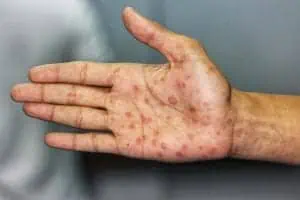Syphilis
Call (877) 900-3223
Syphilis
Skin symptoms of syphilis
Symptoms of syphilis rash
Treatment and prevention
When to see a doctor
Some of the earliest warning signs of syphilis, a sexually transmitted disease caused by a bacterial infection, involve the skin. Common and curable, syphilis is spread through sex (vagina, anal or oral) with someone who has a syphilis sore.
Anyone who is sexually active can contract syphilis. The risk is increased if you have unprotected sex or sex with multiple partners. If left untreated, syphilis can lead to serious, even life-threatening complications.
Skin symptoms of syphilis
In the primary (first) stage of syphilis, you may notice one or more sores, known as chancres, in your mouth or on your genitals. The sores are usually round, firm and painless. If they are located inside your anus or vagina, you might not notice them. The sores typically appear approximately three weeks after having sex with an infected person, though they can appear earlier or later.
Whether or not chancres are treated, they last from three to six weeks and heal on their own — but that doesn’t mean the syphilis is gone. If you are infected and don’t receive treatment, the infection progresses to the secondary stage of syphilis, which involves a rash along with other symptoms such fever, fatigue, sore throat and swollen lymph nodes. Secondary syphilis can develop when the sores are healing or several weeks after they have healed. It can last several weeks to several months.
Symptoms of syphilis rash
During secondary syphilis, a rash may develop on one or more areas of the body. It often takes the form of rough, red or brownish spots on the soles of the feet or palms of the hands. A syphilis rash doesn’t usually itch.
People may mistake a syphilis rash for psoriasis, eczema or pityriasis rosea if they don’t realize they have syphilis. While the rash often appears on the hands or feet, it can also appear on the torso, trunk or extremities. Sometimes it’s hardly noticeable, but in other cases it can cover large areas of the skin.
Secondary syphilis symptoms will disappear whether or not you are treated. During the next stage, known as the latent stage, you won’t have symptoms. But if you don’t get treatment, the infection could eventually — 10 to 30 years later — progress to tertiary syphilis, which can damage the organs and lead to death.
Treatment and prevention
Syphilis is easy to cure with an antibiotic that kills the bacteria. Your doctor will likely give you a penicillin shot unless you are allergic to penicillin, in which case a different antibiotic will be given.
There is no vaccine for syphilis and no immunity from syphilis once you’ve had it — you can be infected a second time if you’re exposed again. Practicing sexual abstinence or mutual monogamy with a non-infected partner are effective ways to protect yourself. Using a latex condom reduces the risk of contracting any STD, including syphilis.
When to see a doctor
If you notice an unexplained sore or a rash and are concerned you may have syphilis, talk to your primary care doctor or dermatologist. A dermatologist can diagnose syphilis rash and treat syphilis with antibiotics.






